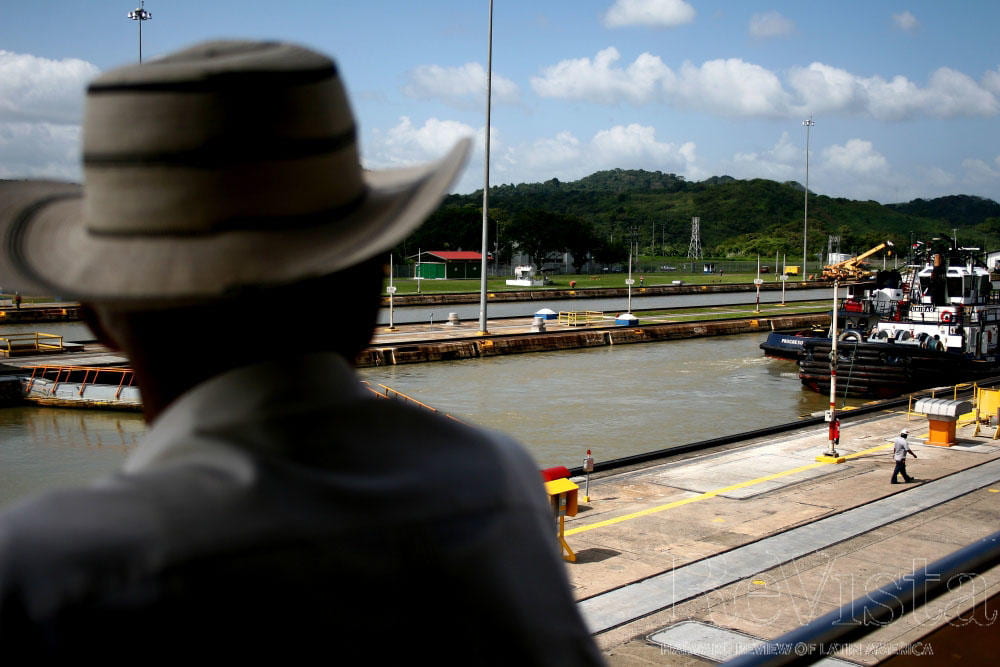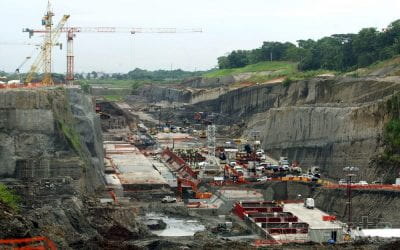Who Remembers Panamá?
Returning the Canal
There was a time, many decades ago, when the Isthmian country of Panamá—dividing the Americas—made near daily headlines from Canada to Argentina. Most of the attention focused on the Panama Canal, one of the world’s greatest engineering feats; a project begun in 1904 and completed in 1914 by the U.S. Corps of Engineers.
As the Panama Canal prepares for a major expansion with its third set of locks in 2014, it’s worth looking back at its history and an unusual connection with U.S. actor John Wayne.
From 1821, Panamá had been a part of the union of Latin American countries called Republic of Gran Colombia. Early in the 20th century, after Colombia rejected U.S. plans to build a canal across the Isthmus of Panamá, the United States supported a revolution that led to the independence of Panamá in 1903.
French businessman Philippe Bunau-Varilla was authorized by Panama’s new government to negotiate a treaty with the United States. The Hay-Bunau Varilla Treaty gave the United States authority to build a canal through Panamá, a project begun by the French in 1881 but later abandoned.
Completion of the canal meant that ships going from the Atlantic to the Pacific no longer had to travel the 8,000 miles to get from one ocean to the other by going around Cape Horn at the southern tip of South America.
The terms of the original U.S.-Panamá agreement provided for perpetual control of a zone five miles wide on either side of the canal.
News accounts at the time noted that division of the country into two parts by the U.S. territory of the Canal Zone would create tension. Residents of the Canal Zone were essentially U. S. citizens and West Indians who worked in the Zone or on the canal itself.
Indeed, anti-American riots occurred in the 1960s, creating pressure on the U.S. and Panamanian governments for cooperative action in resolving the situation.
U.S. President Jimmy Carter eventually signed a treaty in 1977 which agreed to return 60 percent of the Canal Zone to Panamá in 1979. From 1979 to 1999 a bi-national canal commission ran the canal with a U.S. leader the first decade, and a Panamanian administrator for the second decade.
The canal and remaining territory of the Canal Zone were returned to Panamá on December 31, 1999. By 1976, more than nine out of every ten canal employees were Panamanian, helping to make the transition to full Panamanian control much easier.
The 1977 treaty also established the Canal as a neutral international waterway that guaranteed safe passage to any vessel, even in time of war. Since the 1999 transfer of control, the United States and Panamá jointly shared the duties of defending the canal.
Robert Dockery, the executive assistant to the chief of staff for the U.S. Senate Committee on Foreign Relations at the time of the canal transfer agreement, and now a Florida resident, remembers the event well.
Dockery noted in an email: “The two treaties were signed in the fall of 1977 and the Senate gave its advice and consent to ratification in the spring of 1978. The treaty concerning the Permanent Neutrality and Operation of the Panama Canal and the Panama Canal Treaty were approved after 38 days of continuous debate on the Senate floor, making this effort the second longest treaty debate in the nation’s history [bested only by the Versailles Treaty because it extended from one Congress to the next]. As the principal Senate staffer on the agreements, I was on the Senate for all 38 days, preceded by several weeks of Committee hearings during which testimony was received from more than 100 witnesses.
“On June 16, 1978, some 4,000 guests attended the ceremony in Panama City providing for the deliverance of ‘the instruments of ratification, of the two Panama Canal Treaties…’
I was one of those guests. It was a joyous event. Later in the day both [Jimmy] Carter and [Omar] Torrijos [Panama’s military leader at the time] spoke to a large gathering in downtown Panama City [I think the exact location is called Plaza Cinco de Mayo].
“One of my clearest recollections regarding the treaties goes back to a Senate delegation visit to Panama following the signing of the treaties. The delegation was invited to Contadora Island [where the treaties had been negotiated] by then leader of Panama, General Omar Torrijos. During the visit at a luncheon session with Torrijos, he announced there would be a special guest … someone well known to the American delegation. Sure enough, when the time came, the special guest was none other than John Wayne. He and Torrijos had known each other for sometime. [As I recall, Wayne owned property in Panama]. Anyway, Torrijos then spoke to the visiting Senators. And in the course of his remarks Wayne went out of his way to say how much he disagreed with the views of Ronald Reagan about the Panama issue. In short, Wayne encouraged the Senators to approve the treaties and disregard the views of people like Reagan. Later on, as I recall, Wayne sent a letter to every Senator expressing his support for the Canal agreements.
“Wayne’s support was obviously a big help. And even more important was the support of the Dept. of Defense, whose witnesses repeatedly made the point that the U.S. security interests in the Canal required open access to the waterway [as provided in the Neutrality Treaty] rather than ownership of the Canal.
“Also, let me make the point that approval of the Panama Treaties was in very large part a bipartisan efforts, thanks to the cooperation between then Majority Leader Robert C. Byrd [D-W.V.] and then Minority Leader Howard Baker [R.TENN].
“The Canal treaties entered into force at noon, December 31, 1999. They are a testament to the ability of a great and powerful nation to treat a much smaller, less powerful nation with justice, dignity and respect. Jimmy Carter and Omar Torrijos deserve a standing ovation,” Dockery concluded.
Spring 2013, Volume XII, Number 3
Don Bohning is the former foreign editor of the Miami Herald and a longtime reporter in Latin America.
Related Articles
A Tale of Two Flags
A Tale of Two Flags The Last Hurdle When in 1995 President Ernesto Pérez Balladares appointed me to head the commission responsible for the transition of the Panama Canal from U.S. to Panamanian hands, it never crossed my mind that yet another negotiation—unexpected...
The Story That Panamá Decided to Write
A few days prior to the date set for the transfer of the Panama Canal from the United States to Panamá, a reporter from a U.S. news network asked me, “Mr…
The Panamanian Novel
Pueblos perdidos, the novel which earned Gil B. Tejeira Panamá’s Miró Literary Prize for 1963, tells the story of Gatún Lake, at the time the largest artificial…





